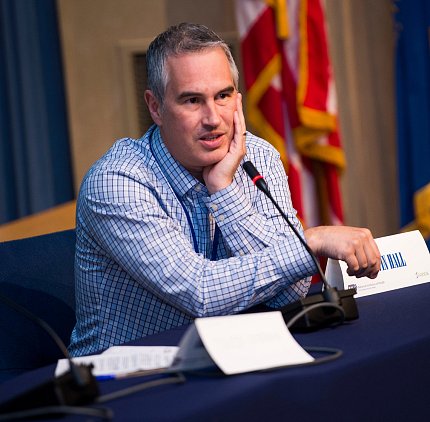Task Force Aims to Identify Best Weight-Loss Strategies

Photo: Lisa Helfert
It’s not just how much, but also what and even when we eat that might affect our health and well-being, according to NIDDK deputy director Dr. Gregory Germino, who spoke recently at the NIH Obesity Research Task Force Seminar Series in Lister Hill Auditorium, Bldg. 38A.
“Questions remain as to what types of diets work best for weight loss and weight maintenance,” he explained during welcoming remarks.
Obesity has reached “pandemic dimensions worldwide,” warned Dr. Estefanía A. Toledo of the University of Navarra’s department of preventive medicine and public health. By 2030, almost 60 percent of the world’s population will be overweight or obese.
Toledo said the Mediterranean diet might be a helpful tool to combat obesity. It’s a plant-based diet that limits processed foods, red meats and dairy products. Observational studies have concluded that those who followed the diet maintained or lost weight and lowered their risk for cardiovascular disease, the leading cause of death in the world.
Right now, she and her colleagues are following participants ages 55-75 who are overweight or obese. They were randomly assigned to intervention and control groups. The intervention group is following a calorie-restricted Mediterranean diet supplemented with olive oil and nuts, plus an exercise and behavioral counseling program. The control group is following a Mediterranean diet supplemented with extra virgin olive oil and nuts. The findings will be published by 2022.

Photo: Lisa Helfert
A decade ago, Dr. Christopher Gardner, director of nutrition studies at the Stanford Prevention Research Center and a professor of medicine at Stanford University, conducted a study of 311 overweight and obese women. Each woman was assigned to 1 of 4 diets. He found there wasn’t much difference between groups. On average, the differences in weight loss among the women in the different diet groups was just a few pounds after 12 months.
“However, what I thought was one of the most interesting observations from this study was that there was a 30-kilogram range of response to the same diet, for all four diet groups,” he explained. Some lost 25 kilograms while others gained 5 kilograms.
Gardner set out to determine from a new study which diet is best for whom. He hypothesized that certain genetic traits and how a person’s body responds to the hormone insulin would predict whether he or she would be more likely to succeed following particular diets.

Photo: Lisa Helfert
In the new and recently completed study, he asked 609 people to cut back to 20 grams of fat or carbs each day. After 8 weeks, the participants could eat more carbs or fat if they felt they wouldn’t be able to maintain their current level long-term, but were advised to keep the carbs and fat “as low as you can, but be able to look us in the eye and say ‘I think I’ve reached the point where I can do this forever.’”
Although he never asked them to cut calories, on average, the participants reported consuming 500 fewer calories each day and lost 6,500 pounds combined. At the end of the study, his hypothesis wasn’t proven; neither the genotype pattern nor the insulin factors that were the primary hypotheses for effect modification were supported. However, the study participants did achieve the same very wide range of weight-loss responses to the healthy low-fat and the healthy low-carb diets, Gardner said, and the study has a rich trove of other possible variables to examine to help explain the massive variability with success.
One of the anecdotal factors the study team observed was that many of the most successful participants noted the approach to dieting taught in the intervention—focusing on choosing quality foods over convenience—“changed their relationship to food,” which may be the topic of Gardner’s next study.
Traditional dieting in which food intake is restricted every day might not be the best weight-loss strategy for everyone, said Dr. Victoria Catenacci, associate professor of medicine at the University of Colorado Anschutz Medical Campus. She thinks the best approach is one that a person can stick to over time.
For some, that might be intermittent fasting, where a person eats every other day. Fast days can be total (meaning no food intake) or partial (meaning a person consumes only 500 calories).

Photo: Lisa Helfert
“The food intake is unrestricted on non-fast days, though healthy portion sizes and food choices should be encouraged,” she said.
Preliminary evidence suggests the diet is safe and tolerable, she said, producing, on average, 3 to 8 percent weight loss, improved body composition and no weight regain. Recently, Catenacci received NIH funding to conduct a 1-year, randomized study that will compare traditional dieting to intermittent fasting.
The time of day a person eats might cause health problems, said Dr. Frank Scheer, associate professor of medicine at Harvard Medical School and director of the Medical Chronobiology Program at Brigham and Women’s Hospital. Those who eat later in the day have less success losing weight compared to those who eat earlier.
The human body has a circadian rhythm, a physiological pattern that follows a 24-hour cycle. He explained that virtually every cell has the ability to generate these rhythms. A single fat cell in a petri dish, for example, has the molecular machinery to generate a 24-hour rhythm.
Studies have shown that the misalignment of a person’s sleep-wake cycle with its circadian rhythm influences glucose tolerance. The sleep aid melatonin can also affect glucose tolerance.

Photo: Lisa Helfert
The misalignment also adversely affects inflammatory markers, blood pressure and the production of leptin, a hormone that controls the feeling of hunger. These findings might explain why people who work nights are at greater risk for obesity, diabetes and cardiovascular disease.
“We suggest some caution having meals close to melatonin intake or close to bed time,” Scheer said.
Studies attempting to determine the best diet “are flawed in certain aspects,” cautioned NIDDK senior investigator Dr. Kevin Hall. Many studies rely on participants to self-report what they eat to investigators. However, self-reported diet measurements are often inaccurate. Furthermore, adherence to diets in free-living subjects is often “abysmal,” even when all food is supplied to participants.
Hall believes researchers need to develop and validate objective measures of diet, such as biomarkers. Development of such methods requires that researchers know what people are actually eating over periods of weeks to months. Such studies will require facilities to house 20-50 study participants and precisely control and measure their food intake.
